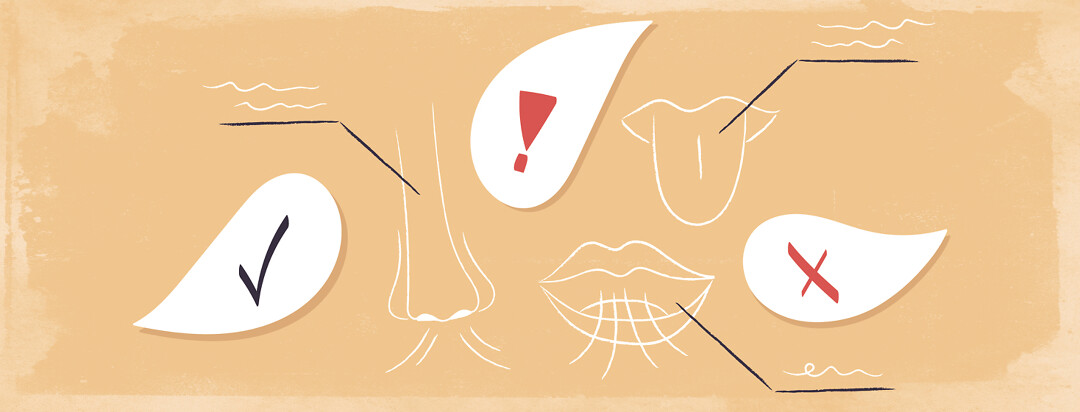My Journey With Buteyko Breathing (Part 1): Establishing Nasal Breathing
“It’s right there in the name, ‘Sleep-disordered Breathing’, and yet breathing is never part of the diagnosis or treatment of sleep apnea.” - Patrick McKeown
I recently had the opportunity to interview Patrick McKeown. He is the founder of the Buteyko Clinic, which teaches breathing re-education. We started by discussing how strange it is that breathing is completely ignored in sleep apnea diagnosis and treatment.
I was diagnosed with sleep apnea more than a decade ago. The only time I was asked anything about breathing was when I was fitted for a full CPAP face mask at the medical supply company.
Mouth breathing vs. nose breathing
When I picked up my continuous positive airway pressure (CPAP) machine, the technician asked me if I breathed through my nose or my mouth. I responded that I had always been a mouth breather. The technician said I should use a full face mask but told me nothing about the benefits of nasal breathing. Indeed, until I read James Nestor’s book Breath last year, I thought there was no difference between mouth and nose breathing.
Breathing re-education
The good news for people struggling with dysfunctional breathing, such as shallow, stressed, and rapid breathing, is that new functional breathing patterns can be learned. Patrick McKeown teaches breathing exercises that involve breathing slowly, lightly, and using the diaphragm.
This method of breathing is at odds with what I had always been taught in yoga classes. In most yoga classes, large deep breaths are encouraged. When I asked Patrick McKeown about yoga breathing, he responded: “Air is just like food. Both are good for you in the right amounts, but too little or too much is unhealthy.”1
What is the Buteyko Method?
The Buteyko Method of breathing re-education involves the following elements:2
- Establishing full-time nasal breathing during wakefulness and sleep.
- Correcting the resting posture of the tongue.
- Slowing the respiratory rate.
- Using breath-hold time (BHT) to establish chemosensitivity to CO2.
- Restoring diaphragm function and the lateral expansion of the lower ribs.
- Reducing the minute volume towards normal to regulate levels of CO2.
A few months ago, I began working through each of these elements, in turn, to see if they could improve my breathing and sleep quality.
Establishing full-time nasal breathing
I had large tonsils as a child and began breathing through my mouth habitually. Even after my tonsils were removed, as a teenager, I continued my habit of mouth breathing. Re-establishing full-time nasal breathing, as Patrick McKeown recommended, took me a few weeks of building up nasal breathing during the day. I was able to ensure nasal breathing at night with the help of some mouth tape.
Correcting the resting posture of the tongue
The Buteyko Method of breathing re-education stresses the importance of tongue posture. Many mouth breathers, myself included, develop a low resting tongue posture. This position doesn’t support proper nasal breathing the way that resting the tongue on the roof of the mouth does.
Myofunctional therapists, also called orofacial myologists, specialize in helping people retrain their tongues to sit in the correct position. I began working with Kaitlyn Shrum, a myofunctional therapist in my area.
My tongue was restricted by a tongue-tie
Working with a myofunctional therapist helped me with my nasal breathing. Lots of myofunctional therapy exercises helped to strengthen and tone my tongue. However, my tongue was being restricted by a tongue-tie, excess tissue underneath the tongue anchoring it down.
Babies sometimes have their tongue-ties “snipped” to help with breastfeeding, but I had no idea that the procedure could potentially help me. I had searched online for information about adult frenectomies. A lot of the accounts seemed very promising, with patients experiencing a reduction in face and neck pain immediately following the procedure.
My frenectomy experience
The procedure involved a dentist cutting the tissue underneath my tongue with a laser. There was a local anesthetic, and it took about 20 minutes. I did notice right away that the tension and aching in my face and neck seem reduced. After the frenectomy, I continued working with my myofunctional therapist to help position my newly released tongue.
Have you considered how your sleep apnea relates to the way that you breathe? Do you mouth breathe? If so, have you considered switching to nasal breathing? What about a tongue-tie? Have you ever considered a frenectomy?
Check out part 2 in this series where Emma shares more about her Buteyko breathing journey!

Join the conversation